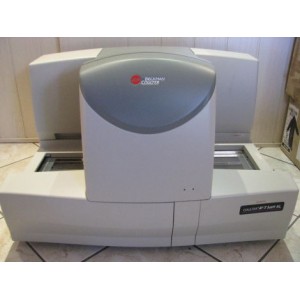The Coulter AcT 5-part differential (5 diff) autoloader (AL) hematology analyzer from Beckman Coulter (Fullerton, CA, USA) was evaluated at the Florida Medical Center in Fort Lauderdale, Florida, an acute care hospital facility.
Categories
-
Laboratory
- Blood Bank
- Analytical lab
-
Clinical lab
- Blood Analyzer
- Blood Gas Analyzer
- Chemistry Analyzer
- Coagulation Analyzer
- Hematology Analyzer
- Hemoglobinometer
- Immunology
- Urine Analyzer
- Microbiology
- Incubator
- Pipetter
- Rotator/ Mixer / Rocker
- Ultraconic Cleaner
- Spectrophotometer
- Water Bath
- Electrolyte analyzer
- Autoclave Tabletop
- Cell Counter
- Staining System
- Slide Stainer
- Rehabilitation equipment
- Immunohematology
- Urinalysis
- Hematology
- Immunology
- Serology
- Photometry
-
Biochemistry
- Siemens
- Roche
- Beckman Coulter
- Bayer
- Abbott
- Horiba ABX
- Wiener Lab
- Diagon
- Dade Behring
- Mindray
- CORMAY
- BioSystems
- HUMAN Gmbh
- CHIRON Diagnostics
- Thermo Scientific
- M.u.T GmbH
- Chema Diagnostica
- Awareness Technologies
- Pointe Scientific
- Teco Diagnostics
- Carl Zeiss AG
- Sebia Electrophoresis
- Ortho-Clinical Diagnostics (Johnson&Jonson)
- Coagulology
- Microbiology
- Gasometry
- Centrifuge
- Imaging
- USG
- EKG
- PH-METR
- Pump Suction
- Drugs detection
- Infection diagnosis
- Protein diagnosis
- Rehabilitation equipment
- Medical Equipment
- Hemecare/Rehab.
- Reagents
- Spare Parts
- Others
- ASAMED SPECIAL OFFER:
Viewed products
Your world of PrestaShop modules, PrestaShop Themes and PrestaShop Templates by PrestaLive.
Beckman Coulter Act 5 Diff AL
The Coulter AcT 5-part differential (5 diff) autoloader (AL) hematology analyzer from Beckman Coulter (Fullerton, CA, USA) was evaluated at the Florida Medical Center in Fort Lauderdale, Florida, an acute care hospital facility. The AcT 5 diff AL is a new, fully automated bench-top 5-part differential hematology analyzer with automatic loading and sampling. It is designed as a front-line instrument for small- to medium-sized laboratories or as a backup in larger laboratories. We evaluated the performance of the AcT 5 diff AL for complete blood counts (CBCs). The Coulter Onyx AL was used as the reference instrument and the 5-part differential against the reference 400-cell manual differential count (2 operators x 200 cells). A total of 140 patient samples were analyzed in the study, with most of the samples obtained from our own laboratory workload. We supplemented this dataset with pediatric and oncology samples from nearby practices. All samples were analyzed within 4 hours of collection, and the AcT 5 diff AL demonstrated excellent accuracy with correlation values (r) > 0.98 for all directly measured CBC parameters (white blood cell count, red blood cell count, hemoglobin, mean corpuscular volume, and platelets). Reproducibility studies on the AcT 5 diff AL also showed excellent results, with coefficients of variation much lower than the manufacturer’s specifications. Initial differential comparisons showed good correlations for neutrophils, lymphocytes, and eosinophils (r = 0.84, 0.96, and 0.88, respectively) with a lower correlation for monocytes (r = 0.43). On subsequent review and data analysis we found differential discrepancies in 39 of the 140 samples, for which all showed multiple morphological flags, R diff flags, or poor scatterplot separations indicating that the AcT 5 diff AL differential was likely to be inaccurate and that a morphological assessment and differential was necessary. Given the acutecare setting that our laboratory serves and the skewing of the dataset of our study because of the addition of abnormal pediatric and oncology cases, these abnormal sample results were not surprising. These 39 samples all had markedly abnormal differentials with either increased numbers of immature and/or abnormal cells due to such conditions as end-stage liver disease, respiratory failure, renal failure, sepsis and pneumonia, high white blood cell leukemias, and a variety of other acute illnesses. Reanalysis of the differential data, excluding these 39 grossly abnormal samples with R flags and multiple flags, showed the AcT 5 diff AL differential gave very good correlations for neutrophils, lymphocytes, monocytes, and eosinophils (r = 0.93, 0.97, 0.66, and 0.85, respectively). Our technologists were also impressed with the reliability of the AcT 5 diff AL, its ease of use and transfer from stand-by to ready mode, the user friendliness of the software, and the clarity of the printed report. We concluded that the AcT 5 diff AL gives accurate and precise CBC and 5-part differential results and is an excellent, easy-to-use instrument ideally suited for small- to moderate-sized hospital laboratories, as a back-up in a large hospital laboratory, or for use in physician office laboratories.
New products
No new products at this time





